Buildings: The Unsung Hero of Public Health


As the world contends with the rise of acute public health threats and the devastating impacts of climate change, we teamed up with five former surgeons general and a number of executives from leading public health organizations to turn the attention of policymakers to an unsung hero: our buildings. That’s right, our buildings play a pivotal role in our well-being, and it’s time our policymakers recognize this.
Buildings shape our health outcomes in profound ways. For example, health benefits from better indoor environments could lead to annual economic gains of $200 billion. Indoor ventilation enhancements could improve cognitive functions by up to 101 percent, translating to a per-person productivity benefit of up to $7,500 per year. Despite these numbers, most policymakers fail to focus on buildings, the spaces and places where we spend about 90 percent of our lives.
In addition to supporting our health, our buildings can also be a bulwark against climate change. As we face intensifying impacts from an already changing climate, buildings that are fortified for health can serve as literal and metaphorical shelters from the storm. They can be designed to counter health threats like extreme heat and flooding while also enhancing our productivity, our comfort and our quality of life. By taking a comprehensive approach, our buildings can prioritize health-resilience focus areas such as indoor air quality, water quality and management, thermal comfort, emergency planning, integrative design, healthy and sustainable materials, healthy lighting environments and food security.
As a case in point, look more closely at just one of these strategy areas: enhancing indoor air quality. Clean indoor air — which requires a series of interdependent strategies across mechanical ventilation, air source control and filtration — is critically important when fortifying indoor environments against well-known climate impacts, including increased ground-level ozone pollution and increased smoke pollution from wildfires, which emit fine particles and in turn increase the risk of adverse chronic and acute cardiovascular and respiratory health outcomes. But there are also increased indoor air quality concerns from rising temperatures, more intense precipitation patterns, and increasing concentrations of atmospheric carbon dioxide. Each of these can contribute to considerably higher levels of certain airborne allergens, which can produce increases in asthma episodes and other allergic illnesses.
Yet many of the same healthy building strategies that can protect us against climate change have also been scientifically proven to help with everything from combating obesity to improving our sleep, from lowering the risk of heart disease to reducing respiratory illnesses and the spread of communicable diseases.
A seminal, peer-reviewed study published last year in the journal Building and Environment found that buildings certified to the WELL Building Standard helped improve worker satisfaction by 28 percent, well-being by 26 percent, mental health scores by 10 percent and productivity by 10 median points.
Those results are part of a growing body of research linking healthier spaces to reduced employee absenteeism, improved cognitive function, and lower healthcare costs for companies, as well as stronger real estate financial returns from rental premiums and longer lease terms.
But we can’t forget how the COVID-19 pandemic exposed glaring gaps in building policy, specifically related to ventilation and indoor air quality. Rather than acting as shields against the virus, all too many of our buildings were ill-prepared to protect us.
As we anticipate future challenges, the argument for health-driven building policy has never been stronger. Fortunately, we’re beginning to see some new legislative ideas that are designed to accelerate healthy building improvements. For example, in the last few years, several bills were introduced to the U.S. Congress that would provide businesses with tax incentives to deploy solutions that help improve indoor environmental quality. The Joe Biden administration too has made noticeable efforts to push for healthy buildings, hosting the first-ever White House Summit on Indoor Air Quality last year.
Public investment in buildings is a huge policy opportunity. Over the next decade, federal, state and local governments will invest hundreds of billions of dollars in our nation’s buildings, spanning considerable funding for affordable housing, federal buildings and schools, and long-term, multi-billion-dollar incentives for the decarbonization of residential and commercial buildings.
The pivotal question for policymakers is whether these investments will also prioritize the people inside, and in doing so, improve public health outcomes. To ensure that’s the case, our decision-makers need to rethink our current building policy framework by elevating health.
A good start would be incentivizing solutions to increase ventilation performance, improve indoor air quality, adopt emergency preparedness plans and support healthy, sustainable materials. We need policymakers to see buildings not just as structures that contain us, but as pillars that uphold our nation’s public health.
Image credits: Abigail Keenan and Robert Bye via Unsplash
ESG Concerns Heat Up in Food and Beverage Supply Chains: Can 2D Barcodes Help?


We know many consumers consider ESG (environmental, social and governance) concerns when making a purchase. 2D barcodes like QR codes offer a seamless way for brands to share relevant information about where a product came from and how it was made, helping their offerings stand out among the competition.
Environmental, social and corporate governance (ESG) concerns are at the forefront of consumers’ minds when they make purchasing decisions today. With recent reports disclosing human rights risks lurking within food and beverage supply chains — and 37 percent of brands having yet to share how they’re evaluating them — consumers are calling for increased transparency, forcing companies to take a closer look at their existing business practices.
Unrooting forced labor and ESG challenges
An estimated 27.6 million people are in forced labor today, ranging from deceptive recruiting and debt bondage to unsafe working conditions and excessive work hours, and 12 percent of them are children. These exploitative practices frequently occur when farming high-risk commodities including fish, beans, cattle, coffee, rice, tea, tomatoes and wheat. Food and beverage companies are fighting back, placing increased scrutiny on these products’ suppliers and canceling contracts with those who are unable to comply with ESG policies. But unrooting forced labor is easier said than done.
The food and beverage industry relies on an intricate network of suppliers and trading partners to facilitate the movement of goods from origin to destination. Our favorite brands often work with thousands of suppliers both domestically and internationally in countries across Europe, Asia and Africa. With expansive supply chains, varying reporting requirements across regions, and resource constraints, it is often difficult to trace ingredients back to their original source and gain adequate visibility into every supplier. These challenges, compounded with a lack of widespread structure for corporate ESG accounting, can allow human rights violations to go unchecked.
How to nurture ESG success
According to the Business and Human Rights Resource Center’s latest analysis, two organizations are navigating ESG better than the rest: Tesco and Woolworths. The companies scored a 52 and 56 on their human rights evaluations compared to the industry average of 16. Tesco, one of the world’s largest multinational retailers with over 3,600 stores in the U.K. alone, requires primary, or first-tier, suppliers in high-risk regions to undergo human rights audits prior to supplying their stores, and submit to additional audits on an annual basis after onboarding. In 2022, the company canceled 28 supplier sites, and temporarily suspended 57 others, due to human rights concerns.
Woolworths, Australia’s largest retailer with 1,261 stores and 18,270 direct suppliers, sources 97 percent of its fresh fruit and vegetables and 100 percent of its meat from Australian farmers and growers. During onboarding, suppliers are segmented based on their risk categories — the higher the risk, the more frequently they’re audited. The company’s non-conformances tied to safety have decreased by 10 percent year over year.
Planting the seed for industry transparency
There are innovative changes on the horizon for food and beverage companies that will increase the visibility and transparency around production processes with partners and consumers. This is especially critical amid the current era of rampant greenwashing, as buyers demand to know their favorite brands are living up to their ethical and sustainable production claims.
To improve consumer transparency, trust and brand loyalty, food and beverage companies are starting to implement an increasingly well-adopted technology: two-dimensional (2D) barcodes.
2D barcodes: What they are and what they mean for ESG
In an initiative known as Sunrise 2027, being facilitated by GS1 U.S., the industry is migrating from the standard UPC barcode – found on consumer packages for almost 50 years — to a 2D barcode.
While 2D barcodes may sound unfamiliar (and futuristic), the technology is more common (and accessible) than you might think. Compared to one-dimensional barcodes (such as the UPC that is used for price lookup to automate checkout), which store information horizontally and can only contain up to a few dozen characters, two-dimensional (or, 2D) barcodes store information horizontally and vertically. This enables 2D codes, such as QR codes, to fit thousands of characters of data, from product batch/lot numbers to URLs.
On top of allowing for enhanced data storage, 2D codes were designed to be easily scanned by smartphones and other imaging devices, allowing for ease-of-use in addition to enabling enhanced information sharing.
2D barcodes will soon give consumers greater visibility into the origins of the products they buy, amongst other use cases. They allow brands to share information on where a product was grown, the factory it was processed in, and the sustainability practices of the company that made it — all while still going “beep” at point-of-sale.
While the retail industry has committed to implementing 2D barcodes over the next four years, some prominent food and beverage brands already use them. Woolworths uses 2D codes to connect business partners across the supply chain with the data they need for inventory management, traceability programs and sustainability initiatives. By early 2022, 2D barcodes were on 50 percent of products in Woolworths’ meat range across more than 1,000 stores. In the future, Woolworths and its suppliers also plan to make their products' sustainability information and certifications — down to the crop and serial number — as well as harvest information (i.e., farm map, pack date, production processes) and recycling instructions readily available to consumers.
The food and beverage industry is in the middle of a pivotal change where transparency is becoming the norm and responsible business practices will dictate growth. By ensuring accountability on ESG compliance now and opening the lines of communication with consumers, food and beverage brands will not only safeguard their own future, but also contribute to a more equitable and sustainable global economy.
Solving the Wind Industry's Waste Problem


Wind power is an increasingly important part of the energy mix as the world works to counter the climate crisis. But with first-generation wind turbines reaching end-of-life, questions loom over how to properly handle the waste they create. While wind turbines are up to 90 percent recyclable, turbine blades in particular present the biggest challenge.
The challenge of recycling decommissioned wind turbines
This is especially true as more wind power comes online. It accounted for 22 percent of all new electricity capacity installed in the United States in 2022, according to the Department of Energy, while also being one of the lowest-cost sources of electricity in America. The sector is poised for rapid growth, attracting $12 billion in capital investment last year alone, according to the DOE.
Undoubtedly, it’s great news that this renewable source is increasing its share. But if we don’t find a way to manage wind turbine blade waste, up to 2.2 million metric tons worth will accumulate in U.S. landfills by 2050, Owens Corning, a manufacturer of glass fibers that are used in the composite materials for wind turbine blades, detailed in its 2022 sustainability report.
The company’s leadership recognizes this is unsustainable, and as a major global supplier to wind turbine manufacturers, Owens Corning is greatly invested with other industry partners in figuring out the best ways to handle retired turbine blades.
After all, "wind is a critical technology for reducing emissions," Patrick Sullivan, strategy director for the composites business at Owens Corning, told us. Somewhat ironically, as wind turbines have become more efficient at making electricity, recycling their blades has become more problematic.
That’s because achieving greater efficiency means modern turbines are designed with much longer blades than those used in first-generation types. “To harness the maximum kinetic energy from the wind, you want as long of a blade as possible to increase the rotor diameter,” Sullivan said. “To have such long structures that support themselves and face various forces over 30 years, it needs to be strong and lightweight. So, that switches you from traditional metals and woods to more advanced composite materials.”
Therein lies the problem. Whereas steel and alloys are mono-materials that are relatively easy to recycle, composites are not. “Blades are designed to last a long time, and the fundamental nature of a composite is you are combining dissimilar materials together that are not designed to come apart,” Sullivan explained.
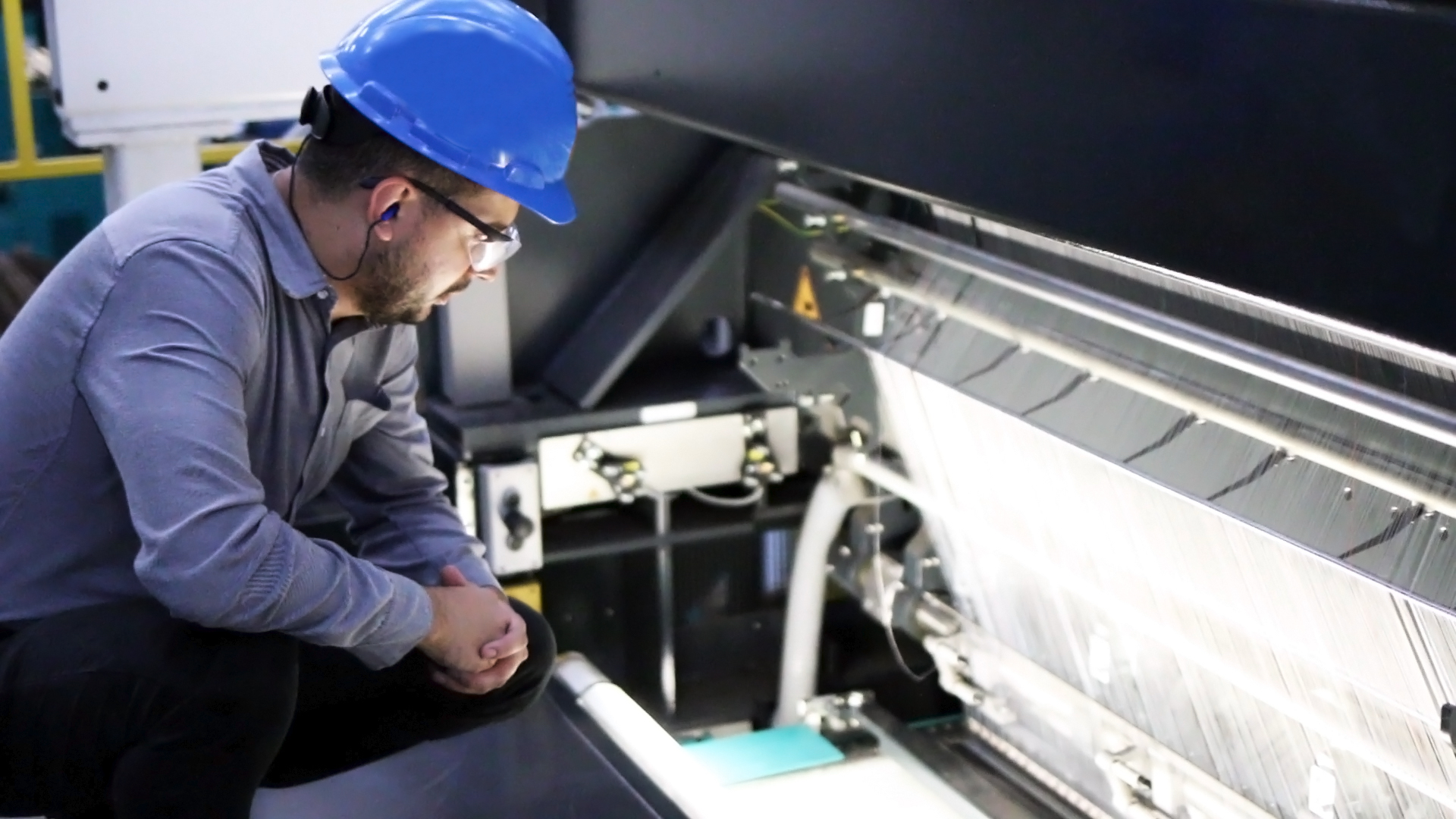
What’s in a wind turbine blade, anyway?
Should you be wondering, a composite wind turbine blade is made from a mix of glass and carbon fibers, which are combined with resins and plastic polymers. These materials wrap a structural core material which might be made of balsa wood or PET plastic foam.
A blade made today is designed to be in service for about 30 years, but the in-service time could be cut short because of turbine efficiency improvements. This means asset owners might elect to retire older turbines, which generate less electricity, in favor of newer and more efficient ones.
“An average turbine is in the 3- to 5-megawatt range,” enough to power 3,000 to 6,000 homes, Sullivan said. “Ten years ago, it might have been a 1-megawatt model,” he told us. As a result, a given area of wind farm can generate far more power today, incentivizing turbine upgrades, or “re-powering” as it’s known in the industry.
Consequently, many old turbines are being taken out of service before they fail, meaning the waste is already piling up. This creates urgency to address the landfill problem today, while the problem will only continue to compound in the future.
How to recycle a wind turbine blade
So, what to do with a retired wind turbine blade that needs to be kept out of landfill? Options range from the very low-tech, to higher-order processing which is more desirable.
Let’s start with the low-tech options. Landfilling blades is already banned in some parts of Europe. Advocates are pushing for a full ban across the continent, with a similar movement growing in the U.S. While this is stimulating a range of efforts for effectively dealing with the problem, at the most basic level it has involved taking blades, shredding them up and burning them in cement kilns as a power source. That’s not ideal, and the only real reason to recommend disposal by such means is that it avoids landfill. Rather than burn them, some wind farm operators have opted to store their blades until viable solutions are found.
“An improvement from cement kilns could be mechanically breaking down the blades and either compounding the remnants into pellets, which can be molded into new composites, or using the fractions in other composite parts,” Sullivan said. “The challenge is parts made with these pellets, for example, will have lower performance than virgin fiber composites. This really starts to limit the pool of use opportunities, as composites are advanced materials in higher demanding applications.” Nonetheless, Owens Corning has been able to provide materials from pellets which have gone into things such as decking materials or railroad ties.
Other novel uses are interesting, too. “People are designing bridges out of old blades,” Sullivan told us. “They are cool projects, but there are thousands of blades in the world,” he said, with the implication that there are simply not enough projects to use all decommissioned blades in creative ways like this.
Instead, Owens Corning sees the greatest potential in taking a materials science approach. “How can we separate the fibers away from the resins?” Sullivan posited. “And what can we do with these fibers in a second life?”
To this end, the company is working with other partners to experiment with recycling processes such as pyrolysis. In very simple terms, pyrolysis involves a process of heating blade material to very high temperatures in the absence of oxygen, leading to a physical separation of materials at the molecular level.
““It has been proven at lab-scale: You can take blade waste through a pyrolysis process and separate glass fiber from the resin systems, and we can take those fibers back,” Sullivan said. This method of recycling avoids downcycling, as recovered glass fibers can be melted down and reused in place of virgin material. “We would love to be able to get the fibers back from that type of process, and our partners from the chemical industry I assume would love to get their polymers back, too.”
But making this commercially viable and cost-effective at scale remains a challenge. That’s in large part because making virgin glass “is relatively very low-cost,” Sullivan said. “The efforts to reduce the cost of wind energy over the past two decades have also trickled down to reduce the cost of glass fibers tremendously,” he added. Energy inputs for pyrolysis need to be considered, too, and Sullivan suggested electrification and green hydrogen might be ways to mitigate the impact of the pyrolysis process in the future.

The future of wind turbine blade recycling is collaborative
Challenges aside, recycling blade waste will become increasingly urgent and indeed a business imperative going forward. “We will be one of the companies to develop circular models. We see it as a huge competitive advantage,” Sullivan said.
Nevertheless, it will take a combined effort. Owens Corning is part of a consortium of companies in the European-based Zebra project, which has a goal of developing the first 100 percent recyclable wind turbine blade. "Part of this effort is to produce blades with zero-waste and design the composite for recyclability, making it easier to disaggregate materials at end-of-life,” Sullivan said.
In addition Owens Corning joined the U.K.-based SusWind project, a consortium of companies launched in 2021 to “facilitate the recyclability of existing blade technologies, drive the use of more sustainable materials and processes, and develop new approaches based on circular design principles,” Sullivan said.
As the wind industry moves toward greater sustainability from end to end, Owens Corning’s efforts are ongoing, too. “We can make a major impact to the wind industry in helping tackle this challenge,” Sullivan said. “The goal is to take that fiber back and deliver recycled content fibers to build high-performing composites.”
Image credit: Thomas Reaubourg/Unsplash and Owens Corning
This article series is sponsored by Owens Corning and produced by the TriplePundit editorial team.
Images courtesy of Owens Corning
Innovating Across the Aisle Solves Social Issues
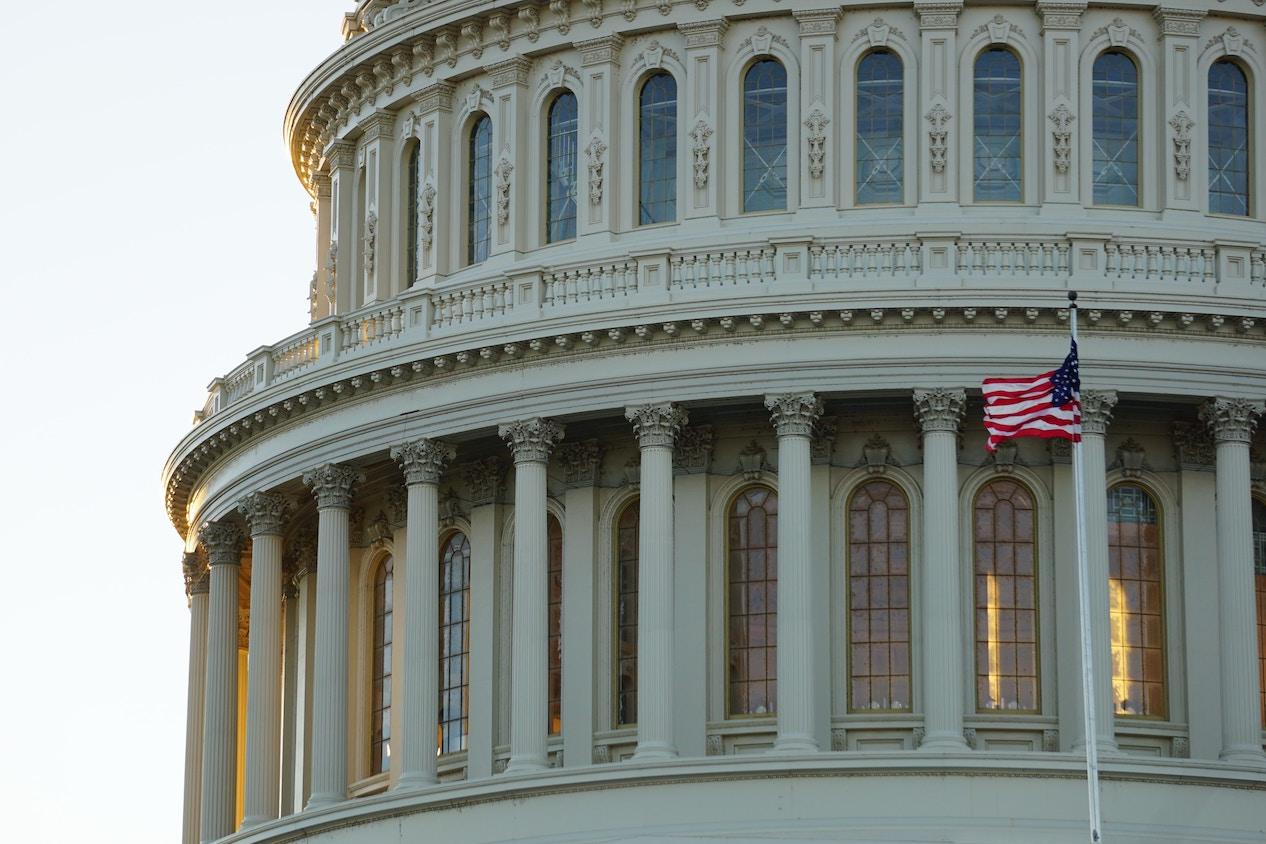
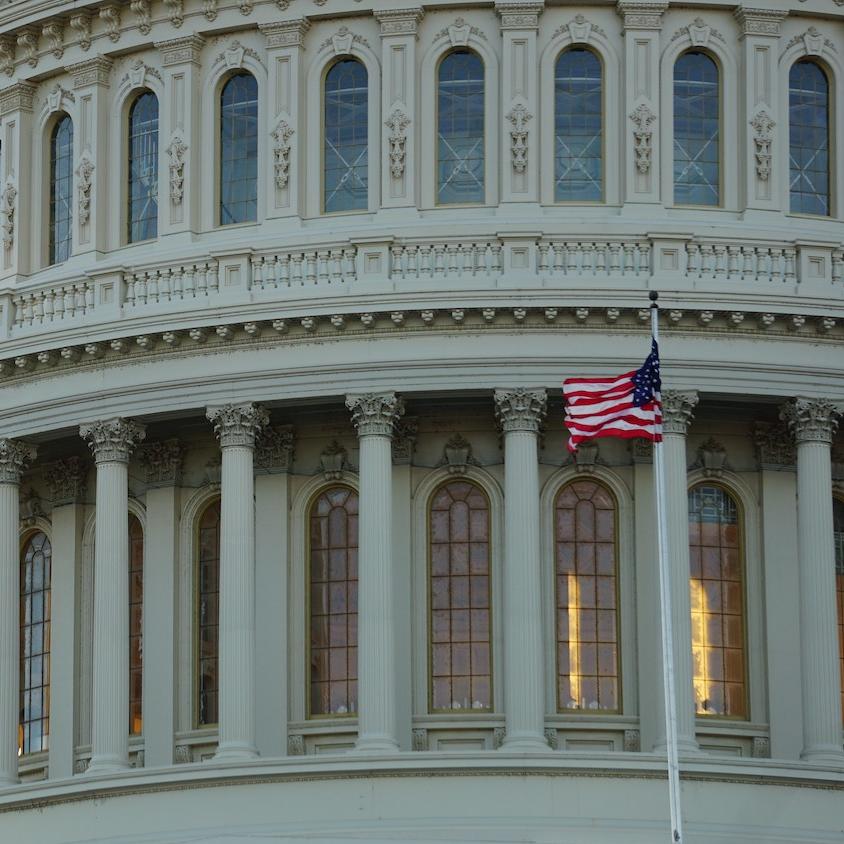
Social entrepreneurs play a vital role in developing innovative approaches to address pressing social issues. Public policy designed to further this work can help push progress forward faster, experts say.
“Policy can hold social innovation back if we just keep funding the same programs over and over again without asking whether the programs are actually effective, and are they actually achieving the desired results for those who need them most,” said Deborah Smolover, managing partner of New Profit and executive director of America Forward.
America Forward, a nonpartisan initiative of the venture philanthropy fund New Profit, works to help social entrepreneurs and policymakers find common ground and shape legislation that encourages the creation of effective and equitable solutions.
Government funding “enormously outweighs and exceeds” private funding for social and human services, so how the government allocates that funding is critically important, Smolover said.
Further, policy can hinder social innovation if it’s focused on outputs rather than outcomes. For example, if a workforce development or economic mobility program measures the number of graduates but doesn’t measure outcomes — such as whether those graduates land good-paying jobs that enable them to improve their living conditions — it becomes difficult to measure the program’s effectiveness and the impact of the government funding.
“We believe that these leaders who are closest to communities and who are closest to the problems have deep expertise, and utilizing that expertise to craft programs and policy solutions can vastly improve public policy,” Smolover said. “Put simply, they know what works, and the power of this expertise is greatest when social innovators collaborate with one another in communities to create policy solutions together.”
America Forward’s creation is rooted in comments by former White House advisor David Gergen, who served in the administrations of presidents from both major parties. Gergen said the potential impact of social entrepreneurs was deterred because the people who were “deeply invested” in effecting social change were overlooking the policies and systems in which their work happened.
“Essentially, by not engaging with government, social entrepreneurs were missing an enormous opportunity for impact, and this really resonated with our social innovation community,” Smolover said. “What I think we’re seeing now is more and more social innovation, and organizations are really interested in policy and advocacy work.”
Since its inception about 15 years ago, America Forward grew into a coalition of more than 120 social innovation organizations reaching 9 million people in more than 15,000 communities nationwide. To date, the America Forward network has leveraged nearly $2 billion and directed millions of federal resources toward programs that are achieving measurable results for those who need them most.
In recent years, nonprofit organizations have slowed their lobbying of policymakers, Smolover said. That's not because lobbying is viewed as less important, but because many nonprofits lack the necessary resources and access to advocacy, training, support and tools.
“That is why we believe our work at the America Forward Coalition is so vitally important and so valued among our social entrepreneurs because, by advocating together, they’re both more powerful and more efficient,” Smolover said. “We have tried to meet that need by offering more trainings through our America Forward Advocacy Institute, which is basically designed to help social entrepreneurs become better, bolder advocates.”
The institute saw a record number of requests for training in this past year, she said. The exceedingly polarized political landscape in the U.S. highlights the urgency of finding common ground to address social problems.
“We are a non-partisan initiative seeking bipartisan policy solutions with a team that is very diverse along many dimensions, including prior experience working on both sides of the aisle,” Smolover said. “We know that to get policy passed, we need to be able to cultivate a diverse group of champions across many different ideologies and political points of view. We’ve been able to do that time and time again in every administration, in every Congress, with varying makeups.”
America Forward’s successes include spearheading the creation of the Social Impact Partnerships to Pay for Results Act, a $100 million pay-for-success demonstration fund administered by the Department of the Treasury. It invests in innovative state and local partnerships that compensate providers on the basis of measurable improvements in people’s lives, from expanding workers’ earnings to reducing child abuse and neglect.
The coalition was also instrumental in the creation of the Social Innovation Fund, which invested more than $400 million in locally driven, evidence-based innovations in partnership with intermediaries across the nation.
Now, America Forward is working with representatives on both sides of the aisle to generate support for key provisions of those bills, the Workforce Development Innovation Fund, and the RESET for America’s Future Act, in larger reauthorizations that are moving forward.
“It’s not that every mentoring organization or economic mobility organization has the same viewpoint or has the same proposed solution,” Smolover said. “We’ve become very adept at working with different viewpoints within our coalition. And then, working to find not the least common denominator, but those sets of common principles that all of our organizations can agree on, and come up with a narrative that we feel can reach leaders of varying political ideologies.”
Image credit: Ian Hutchinson/Unsplash
Regenerative Cotton Makes an Impact: Just Ask Brands Like the North Face


A regenerative cotton farm in Alabama. (Image: Indigo Ag)
Cotton is ubiquitous, found throughout our daily lives. We find cotton in clothing, bedding, cloth napkins, towels and countless other textiles. It has been used for millennia and is a durable, natural textile material.
Today, a tightly woven collaboration among farmers, scientists, and businesses are applying scientific rigor and data quantification to measure the positive outcomes attained when farmers utilize regenerative practices to grow cotton. Regenerative farming practices employs strategies, such as using cover crops and reducing tillage, that help to restore soil health and biodiversity while leveraging nature to reduce or eliminate the need for chemical additives.
A virtuous loop for companies and consumers
With science showing the potential environmental benefits gained when farmers use regenerative agriculture practices, companies are starting to source more of their materials from farmers who employ these practices as a way to help lessen their environmental footprint. In the textile and apparel space, a good example is VF Corporation (VF), one of the world’s largest apparel, footwear and accessories companies that includes iconic brands such as The North Face, Timberland, Vans and Smartwool.
The company began developing a framework and strategy to achieve greater progress on environmental stewardship and social responsibility back in 2016. Three years later, it was among the first in its sector to set an approved science-based target to reduce Scope 1, 2 and 3 greenhouse gas emissions by 2030.
“Our purpose statement is focused on the betterment of people and the planet,” said Jeannie Renne-Malone, vice president of global sustainability at VF. “And we are committed to designing products that align with and advance our purpose.”
When mapping its environmental footprint, similar to the textile industry as a whole, VF found that a vast majority of its environmental impacts, about 70 percent, occur during the extraction, processing and production of raw materials.
In an effort to decrease that impact, together with The North Face, VF initiated a partnership with Indigo Ag, a science and technology company for sustainable agriculture, through the Carbon by Indigo program. The success of that initial relationship led additional VF portfolio brands to participate in Indigo Ag’s Market+ Source program.
“The use of regenerative farming practices has the potential to improve soil health, and allow for more carbon capture in the ground rather than emitted into the atmosphere, and overall provide net beneficial impacts for the environment, farmers, and local communities” Renne-Malone said.
Cotton, rubber, wool and leather are among VF’s topthe raw materials that the company VF seeks to make more sustainable throughout its supply chain. The Market+ Source program helps to make this vision attainable for cotton, she said.
“What’s so compelling about regenerative agriculture is it gets back to a more traditional and natural way of growing crops and managing the land,” Renne-Malone said. “When cotton is grown using regenerative agriculture practices, such as those used by the farmers Indigo Ag works with, we’re seeing improvements in water cycles and soil health. Additionally, we’re aiming to help improve economic diversity for farmers and their communities through crop diversity and reduced use of fertilizers, herbicides and pesticides.”
Regenerative agriculture begins with the farmer
Fifth-generation Oklahoma farmer Eric Kahle, a partner with The North Face and Indigo Ag for cotton production, embodies Renne-Malone’s enthusiasm.
“Our family was seeing erosion issues, weed problems, and expensive fertilizer bills,” Kahle said. “We are attempting to solve all of those problems and more, as we learn about how important biology is in running not just our crops, but the entire earth.”
Getting in sync with nature yields tangible benefits. “Instead of us having to buy something, the land already gives it to us,” Kahle said. “Through working with the processes natural to the earth, we save money, make a profit and feel good about doing it.”
One cost-saver Kahle shared is reduced tillage through the use of cover crops. Tillage equates to expensive fuel use and soil damage. Cover crops reduce the need for tilling the land and also provide nutrients to the soil with less or no added fertilizer. “It’s like not having to take a vitamin because you’re eating full foods,” Kahle explained.
Cover crops also bring the benefit of better water management, an important point of progress for cotton production, which traditionally has a high water footprint. The rains are often plentiful at Kahle’s farm in Oklahoma — sometimes too plentiful. They recently reported six inches of rain in a single week.
“We can't always absorb that into the soil,” Kahle said. "We might get an inch … that’s actually usable and doesn’t run off. So, the way cover crops help the soil trap that moisture and retain it for long-term use is incredible.”
That not only saves money with reduced irrigation, but it also fights erosion from water inundation. And with the big winds of Oklahoma, the cover crops provide a buffer for both the soil and the cotton plants.
Like the environment, farmers face hazards from chemical introductions to soil and crops — another reason Kahle is highly focused on soil biology, a strength of Indigo Ag’s scientific rigor.
“We will be able to produce better crops, more affordably and with higher quality, which is healthier for those that consume it, those that use it, those that wear it — and the cattle, deer, birds, all of them,” Kahle said. "Everything in our environment will become healthier if we first heal the soil.”
The value of “boots on the ground”
Indigo Ag’s personnel work directly with agribusinesses and farmers — from data scientists quantifying progress to agronomists like P.R. Morris, who advises on how to implement regenerative practices.
“Soil is its own ecosystem,” Morris said. To best promote the health of that ecosystem, Indigo Ag advises following a set of five principles, including armoring the soil, minimizing its disturbance and integrating livestock. Morris helps farmers start small and ramp up such beneficial practices — a pragmatic approach that helps farmers manage the economic risk of trying methods that differ from long-standing conventional farming.
One of Morris’ favorite regenerative practices to start with is cover crops. “I absolutely love cover crops,” he said, referring to the practice of planting quick-growing, small crops between or during the big cash crop cycles. Along with the erosion prevention and water management Kahle mentioned, cover crops help suppress weeds, resulting in reduced herbicide use and costs. They also protect the soil with living roots in the ground and shade from UV damage.
“The easiest thing to do is just a single species — wheat, because it's cheap, or cereal rye,” Morris said. As a next step after a grain or grass cover crop, he often advises the addition of legumes.
“Legumes pull nitrogen out of the air and fix it in the ground,” Morris said, a benefit to reducing fertilizer use and cost.
Each group of cover crops has its own unique, biological superpower. Taproot crops, like radishes, are good at breaking up compacted soil, while grasses and legumes are perfect for summer grazing. All of these soil boosters give cotton roots and young plants a stronger start, with ongoing protection during the growing cycle, which leads to higher-quality cotton. And every cover crop helps bring more carbon into the soil, so adding and maintaining cover crops can also help farmers qualify to earn carbon credits through Indigo Ag.
Cotton’s broad reach
The North Face brand’s purchase of registry-issued carbon credits was a first step for VF into the relatively new frontier of quantifying the environmental impact of regenerative cotton. Today, the brand offers consumers apparel made from cotton grown using regenerative agriculture practices from its early partnership with Indigo’s Market+ Source program. At the same time, Timberland and Vans are similarly working on how to incorporate this fiber into their product lines in the future. Renne-Malone captured what VF’s experience means.
“We know we cannot meet our sustainability goals alone,” she said. “I hope that other brands that source cotton — in our sector and beyond — consider the benefits that investments in regenerative agriculture practices can garner and help scale these practices to bring even greater benefits to farmers and our communities around the world.”
Strengthening the roots of a plant gives it resilience. Expanding regenerative agriculture practices through this type of partnership promises the same benefits for people and the planet, starting from the ground up.
Learn more from Indigo Ag about the progress being made to make agriculture more sustainable for people and the planet.
This article series is sponsored by Indigo Ag and produced by the TriplePundit editorial team.
The IRS Has the Power to Unlock the Future of Heat Pumps


In the year since the enactment of the U.S. Inflation Reduction Act (IRA), more than $270 billion in private investments flowed into more than 80 domestic clean energy projects and manufacturing facilities. This surpasses the cumulative investments made in such projects over the previous eight years.
At the same time, individuals are capitalizing on IRA-incentivized opportunities to enhance the sustainability of their homes. However, due to a technicality, many homeowners are constrained from accessing one of the most sustainable sources of heating and cooling available today: geothermal heat pumps.
Heat pumps use electricity to move heat in and out of a space. Refrigerators and freezers use heat pumps, but many building managers and homeowners are turning to the devices to heat and cool buildings, too.
Geothermal heat pumps rely on the steady temperature found underground to pull heat into the home during the winter and as a place to dump heat from inside a home to cool it. Ground loops — plastic pipes filled with water and antifreeze — facilitate the heat exchange. With system lifetimes of 50 to 100 years, ground loops can provide cost-effective clean energy to a building for the long term.
Due to various constraints like location restrictions, its potential to cause small earthquakes, and high start-up costs, geothermal electricity production is only possible in a limited number of environments around the world. But geothermal heating and cooling can be installed anywhere.
“In order to get fossil fuels out of homes and businesses, we need to move to heat pumps,” said Heather Deese, director of policy and regulatory affairs at Dandelion Energy, a supplier of geothermal heating and cooling systems. “There are higher upfront costs to install a ground loop, but the returns come quickly with lower heating and cooling bills.”
Homeowners in many parts of the United States would save hundreds or thousands of dollars in energy bills with a switch to geothermal heating and cooling, but current regulation is hampering widespread adoption.
“Individuals can get tax credits if a geothermal business puts a system on the property, but the business owner needs to be able to claim the tax credit in order to make this deal work. There is currently a question about their ability to claim the tax credit for the ground loop installed on a property,” Deese said. “In the past, due to government policies and priorities surrounding climate and clean energy, the IRS has provided safe harbor, to reassure third-party system owners that they won't try to catch them on a technical detail. That’s what we are looking for from the IRS now.”
The U.S. Internal Revenue Service (IRS) allows third-party ownership programs for people who want to install rooftop solar panels but do not want to purchase their own system and pay for installation. These programs allow companies to use homeowners’ roofs and pay them for the electricity that their solar panels produce. Today, a third of all U.S. rooftop solar installations are governed by a third-party ownership arrangement. Geothermal providers want the same considerations for their geothermal heating and cooling systems.
An IRS safe harbor guidance for these systems on top of the tax credits available through the IRA would be a boon for clean energy, Deese said. “If we can unlock third-party ownership, we project 40 to 50 percent faster growth,” she said. “Which means 90,000 new geothermal drilling and HVAC installation jobs and 64 million metric tons of greenhouse gas emissions saved.”
While manufacturers are constantly innovating heat pumps for greater efficiencies, the beauty of the geothermal heating and cooling system is in its simplicity, Deese said.
“I am so enthusiastic about working in this industry because in some ways this really is low-tech,” she said. “The geothermal ground loop is literally number two plastic made into a loop in the ground, with water and a little bit of antifreeze that is circulated to either pick up heat from the ground or transfer heat to the ground. It can feel like magic.”
Image credit: Dan LeFebvre/Unsplash
Why the Fight Against Childhood Cancer Matters and How to Support the Cause


This year Alex’s Lemonade Stand Foundation and the Northwestern Mutual Foundation are reigniting the social media campaign #LemonTopChallenge, encouraging followers and supporters to take a photo or video of someone balancing a lemon on their heads to raise money for research in honor of Childhood Cancer Awareness Month. (Image: Northwestern Mutual Foundation)
Cancer is the leading cause of death by disease for children. However, only about 4 percent of federal funding for cancer research went to childhood cancers over the past decade. While spending bills passed in 2022 provided a much-needed boost for childhood cancer research, funding is still far short of what’s needed, and private fundraising efforts remain critical.
“Every day, more than 1,000 children worldwide are diagnosed with childhood cancer,” said Steve Radke, president of the Northwestern Mutual Foundation. “A childhood cancer diagnosis changes the lives of an entire family, not just the child undergoing treatment, forever. It’s important for these families to receive the support they need not only medically, but mentally and financially.”
We know research has led to significant improvements in the survivability of childhood cancer. In the last three decades, mortality rates from cancer in children and teenagers fell by more than 50 percent. However, there’s still an urgent need for new advances and continued research to help identify effective treatments necessary to further reduce childhood cancer mortality and identify treatments for rare and under-researched forms of cancer.
To help fill this gap, Northwestern Mutual and its foundation have contributed more than $50 million to the cause, funded more than 600,000 hours of research, and supported hundreds of research grants since 2012. Those grants include the Young Investigators Grant designed to support early-career physicians and scientists who are pursuing promising childhood cancer research ideas.
Dr. Erica Braverman, for example, is in the second year of her Young Investigator project. She’s studying ways to improve CAR T-cell immunotherapy treatments, which essentially reprogram a patient’s own white blood cells to find, attack and eliminate cancer cells. Her research on the role of immunometabolism in pediatric cancer will advance the field by improving response to immunotherapies in pediatric cancer patients.
“We take pride in knowing there are kids today who are cancer-free thanks to the research we have helped fund,” Radke said.
Northwestern Mutual’s support of childhood cancer research grew out of a passion for helping to alleviate some of the financial anxiety that families face when dealing with a childhood cancer diagnosis.
“Our mission as a company is to help relieve Americans of financial anxiety and invest in the future of our community,” Radke said. “For many families … the diagnosis and treatment associated with childhood cancer is an emotional and financial burden they did not anticipate. We recognize the financial implications and are uniquely positioned to help those families with the services we offer through our field of advisors, but also through our foundation.”
The company’s employees also support local childhood cancer organizations within the communities where they live and work, from galas to golf outings to music events, “they’ve helped greatly in fundraising efforts throughout the past 12 years,” Radke said.
The Northwestern Mutual Foundation partners with charitable organizations and research centers to fund specific programs, such as the Ronald McDonald House, the Children’s Hospital of Wisconsin, Beads of Courage and TeamConnor.
In particular, the Northwestern Mutual Foundation shares a special relationship with Alex’s Lemonade Stand Foundation, a national pediatric cancer nonprofit dedicated to changing children's lives through impactful research, raising awareness and supporting families to help cure pediatric cancer. Through this partnership, Northwestern Mutual has sponsored notable and future scientific leaders by funding grants for students, early career researchers, and scientists pursuing innovative approaches to some of the greatest challenges in pediatric cancer research.
"With the help of Northwestern Mutual, we’ve provided life-saving grants, empowered the next generation of researchers and created programs dedicated to helping families affected by childhood cancer,” said Liz Scott, Alex’s mom and co-executive director of the Alex's Lemonade Stand Foundation.
To further the cause, this year Alex’s Lemonade Stand Foundation and the Northwestern Mutual Foundation are reigniting the social media campaign #LemonTopChallenge, encouraging followers and supporters to take a photo or video of someone balancing a lemon on their heads to raise money for research in honor of Childhood Cancer Awareness Month.
For every post shared to Facebook, Instagram, Twitter or LinkedIn in the month of September, Northwestern Mutual will make a $10 donation to the Alex’s Lemonade Stand Foundation, up to $500,000. Participants must use the hashtag #LemonTopChallenge and tag @alexslemonadestandfoundation and @northwesternmutual.
Radke hopes the result of the foundation’s ongoing fundraising will help inspire other business leaders to find their own philanthropic callings.
“When it comes to finding a cause that is meaningful for an organization, it’s important to think with a long-term mindset,” he said. “The most impactful results happen over time, not immediately, but it is through funding and volunteer commitments from companies and organizations where change can happen. I hope that the work we and others are doing in this space sparks others to choose to get involved. As they say, it takes a village.”
This article series is sponsored by Northwestern Mutual and produced by the TriplePundit editorial team.
Climate-Smart Agriculture Starved for Cash Despite Outsized Impact on Global Warming


Food production generates a third of greenhouse gas emissions, but spending to reengineer farming practices has yet to reach the levels needed to slow global warming, experts said at the Concordia Summit in New York City this week.
Climate-smart agriculture is on the agenda for the United Nations climate conference, COP28, in November, and sustainable development professionals in New York got a preview.
“Right now, the food system … is about a third of the emissions. Business-as-usual takes it to being, by far, the largest source of emissions by mid-century unless we do something,” said Michael Doane, global managing director of food and freshwater systems for the Nature Conservancy.
Far from a future threat, Doane pointed to a climate-related 20 percent reduction in food productivity and a correlating 50 percent rise in food prices worldwide since 2000.
“We need to reinvest in better seeds, better inputs, but also reinvest in nature. That’s the opportunity,” Doane said, pointing to the conservancy's long-term research partnership with the U.S. Department of Agriculture and an initiative with McDonald’s to improve beef production practices in Nebraska.
Doane joined Chavonda Jacobs-Young, undersecretary for research, education and economics and the U.S. Department of Agriculture’s chief scientist, in applauding sharply higher federal funding for food and agriculture while cautioning that more spending is needed across the globe.
“We have over 700 million people in the world today who don’t have enough to eat,” Jacobs-Young said, adding that by 2050, there will be 2 billion more mouths to feed. “The numbers are staggering.”
The 20-year USDA veteran said centuries of data on regenerative agriculture can be applied to producing more food while using less water and safeguarding soil, including no-till farming for crops and biomass fermentation for proteins.
“The practices exist,” she said. “Our producers need resources. They have to be able to make money.”
Ahead of the COP28 climate talks in Dubai, 53 countries and 500 companies and partners have pledged $13 billion to a climate-smart agriculture coalition, AIM for Climate, started by the United States and United Arab Emirates to boost investment and innovation in agriculture by 2025.
“One of the things that became clear this week in many conversations is how little the ag sector is getting in climate financing,” said Jon Banner, chief impact officer for McDonald’s, who moderated the Concordia Summit panel. “There’s anywhere from $300 billion to $600 billion in climate financing, and only 3 to 6 percent is going toward agriculture.”
With a presence in 120 countries, Banner said McDonald’s feeds 65 million people and is committed to using the company’s scale for good.
“We know the benefits of climate-smart agriculture. We know the benefits of renewable electricity in trying to decarbonize the world. We’re all trying to keep global warming to 1.5 degrees. We know that to feed a global population, that’s no small task.”
Image credit: Francesco Gallarotti/Unsplash
Way More Than WiFi: This Program Upskills Students in Robotics and AI
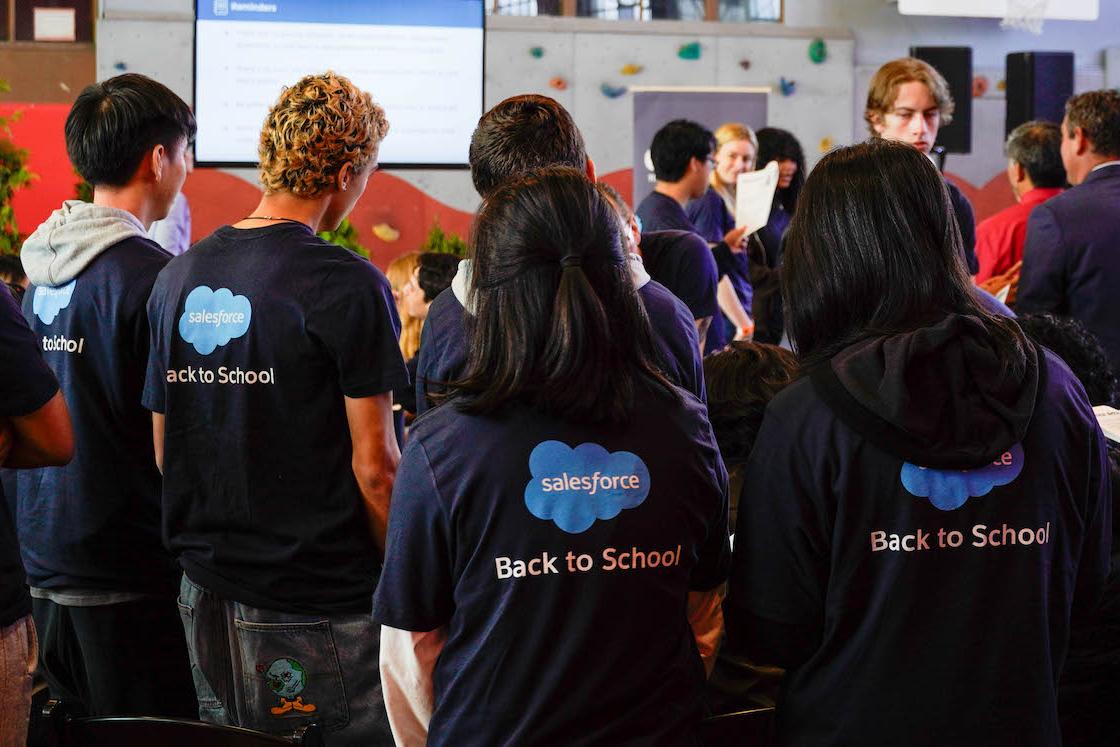
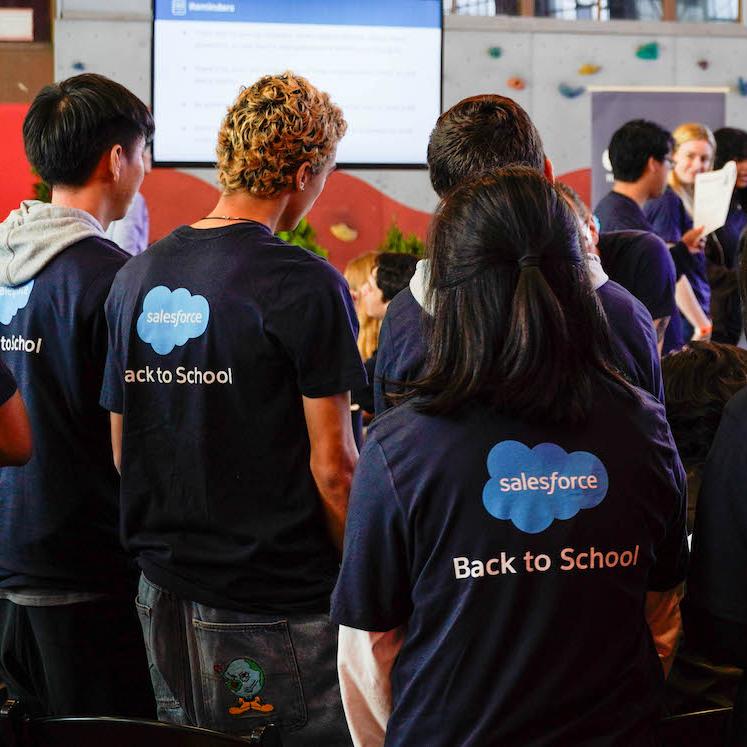
Students participate in hands-on artificial intelligence workshops during Salesforce's "Back to School" event at George Washington High School in San Francisco, ahead of the company’s annual Dreamforce conference. (Image: Taylor Haelterman)
Students in middle school today will build the technological breakthroughs that rival the science fiction of tomorrow. That future is built on the foundation of knowledge they gain now, yet many schools don’t have the funding for updated STEM (science, technology, engineering and math) programs.
That’s where the San Francisco-based software giant Salesforce is stepping in. At a press event ahead of its annual Dreamforce conference in San Francisco last week, the company announced over $20 million in grants to support student success as new technology, like artificial intelligence, rapidly changes the future prospect of their careers.
“As a tech company, we really start from a place of believing business can only really be successful if our communities are strong and our schools are strong,” Becky Ferguson, senior vice president of philanthropy at Salesforce and CEO of the Salesforce Foundation, told TriplePundit. “We know our future workforce is these young people today. How do we invest in and support their relevant learning and growth, so that they are set up for success?”
School districts in San Francisco, Oakland, New York City, Chicago and Indianapolis received a total of $14 million. Workforce development and education nonprofits in the United States, France, Germany and the United Kingdom received a combined $6.8 million.
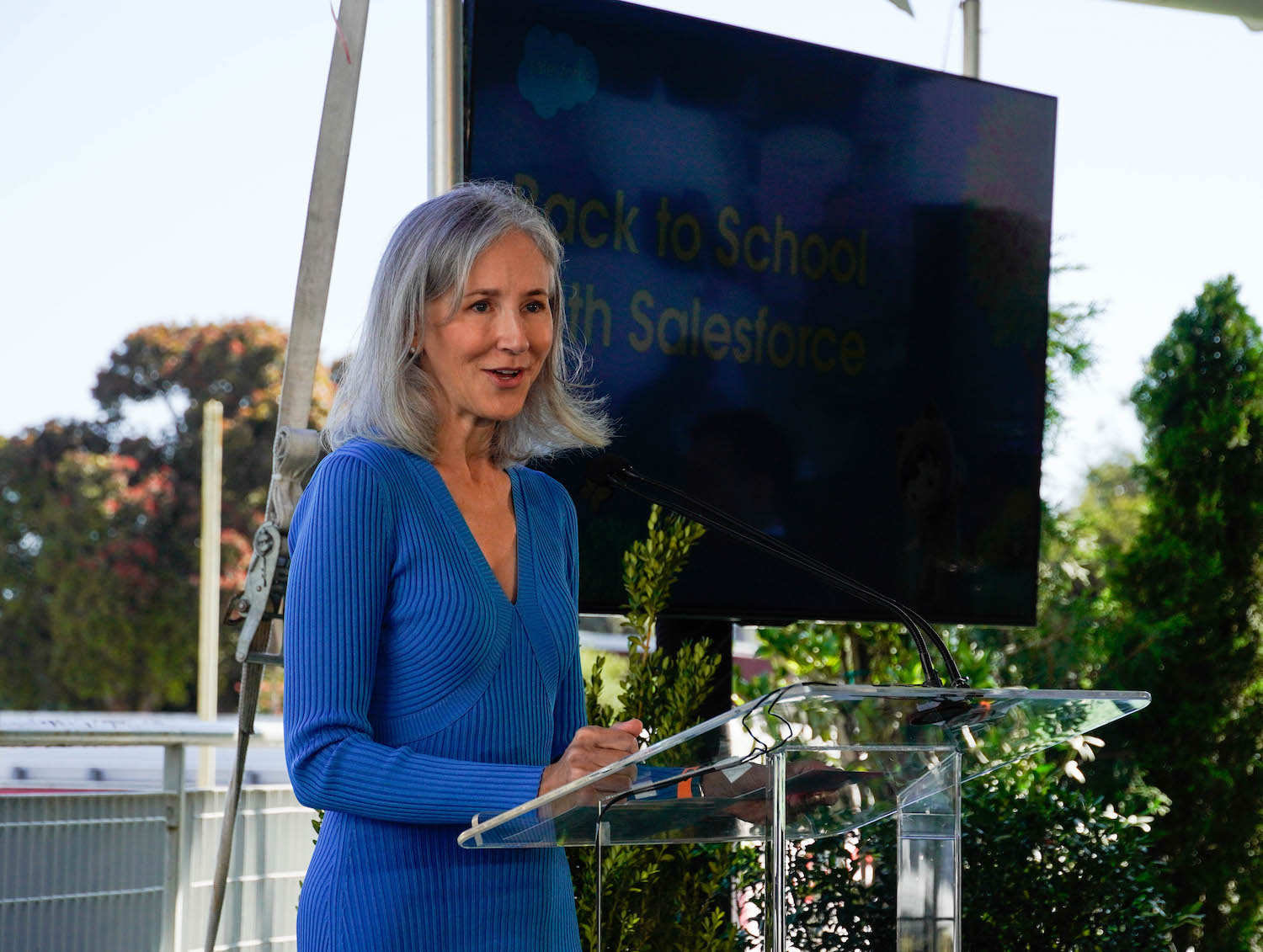
A core focus of the program is providing STEM courses for middle school, but the recipients are in the driver’s seat when it comes to curriculum and policy decisions, Ferguson said. Funding use varies widely from advanced high-school courses and tutoring to preparing teachers to deliver relevant lessons.
Students at George Washington High School in San Francisco, for example, can join a robotics program that competes with other schools around the country or an English class about science fiction and how technology like AI impacts the world. Students in Chicago can start earning college credits while in high school. And youth in the nonprofit workforce development programs can gain in-demand skills and career experience without needing to pursue a college degree.
Accessing these opportunities early in life can spark interest, open new doors, and help young people envision different opportunities for themselves, Ferguson said.
“We could probably all think back to when we were in middle school or high school and a teacher we had, or a course, or a thing you got to be a part of, was just like that little lightbulb,” she said. “When you look back like, ‘Wow, that really helped me go down a different path, or helped me think differently about myself and what I could see myself doing.’ So, we're hoping that we're igniting a lot of those different moments for a really diverse set of students.”
Student needs have changed a lot since Salesforce’s education grant program started in San Francisco 11 years ago. One of the biggest challenges isn’t the innovation itself but building enough trust that partners feel comfortable having honest conversations about what’s working and what isn’t, Ferguson said. The company wants to meet the areas of greatest need for each grant recipient, and that requires listening to them and evolving the program.
“What we might have supported in the first year has grown and looks very different over time, as we adapt to the needs and realities of our partners and the challenges facing schools and young people,” she said. “Some of the early work was just about helping schools get wired to have internet access in the classroom, and then an acknowledgment of . . . that alone is not sufficient.”
Today, at least 25,000 students (about 50 percent) in the San Francisco Unified School District have taken one or more computer science courses, according to Salesforce. And enrollment in computer science courses for Black, Latinx and Indigenous students has tripled.
The students taking these courses are a reflection of the diverse student body population, Ferguson said. Leveling the playing field that way is crucial to unlock opportunities for everyone, regardless of race or gender.
Grants from Salesforce also allow the Oakland Unified School District to retain high-performing, diverse teachers, the company says. The district’s middle schools are at their lowest staff vacancy rate in four years.

And George Washington High School was able to overcome its biggest challenge to implementing this type of program — funding, John Schlauraff, the school’s principal, told TriplePundit. Programs like robotics, which requires a lot of funding and new materials every year, might not exist without these grants.
One thing educators don’t have to be concerned about is student interest.
“Our students are very excited to be involved with this new wave of AI,” Schlauraff said. “We have a lot of ways to expose students to AI and technology. I think they find their niche at the school.”
*Travel and accommodations in San Francisco were provided by Salesforce. Neither the author nor TriplePundit were required to write about the experience.
California's Climate Risk Disclosure Rules Are the Talk of Climate Week


California Gov. Gavin Newsom joins New York Times correspondent David Gelles on stage at Climate Week, where he announced he would sign a pair of recently passed bills that mandate climate disclosure from large companies operating in the state. (Image: The Climate Group/Flickr)
World leaders, business executives and activists are back in New York City for Climate Week and the United Nations General Assembly — and everybody's talking about California.
In case you missed it: Last week California legislators approved a pair of bills that require all large public and private companies operating in the state to disclose their greenhouse gas emissions to investors and the public. Business leaders organized by the sustainability nonprofit Ceres came out in support of the bill before it passed. They say their progress in tracking and disclosing the full scope of their emissions proves it's possible for other companies to do the same.
As lawmakers and business coalitions enjoy a victory lap at Climate Week, we're taking a closer look at the landmark legislation and the ripple effects it could send well outside the Golden State.
Why corporate climate disclosure matters
"There was a billion-dollar weather and climate disaster event every four months in our country in the 1980s. By 2010, there was one every three weeks," Mindy Lubber, CEO and president of Ceres, said at a press conference on Tuesday. "This year, we've experienced more than a billion-dollar event every two weeks."
Indeed, extreme weather cost the United States nearly $40 billion in the first eight months of 2023 alone. But the impacts these disasters and other climate disruptions have on corporate bottom lines is less understood, because many companies don't calculate it. "People are operating in the dark," Lubber said. "I can tell you of the 700 investors we work with, they want to understand: What are the risks from climate [change], and what are the opportunities? They cannot make a decision about building a portfolio without adequate information."
In 2022 surveys, 70 percent of U.S. investors said they would support mandatory climate disclosure in the U.S.
What the California climate disclosure rules require
The two recently passed bills — Senate Bill 253 (SB 253) and Senate Bill 261 (SB 261) — are on Gov. Gavin Newsom's desk, and he confirmed this week that he will sign them. The bills require the California Air Resources Board to develop rules that mandate public and private companies with annual revenues exceeding $1 billion to disclose their greenhouse gas emissions.
Crucially, the rules will cover emissions created upstream and downstream in a company's value chain (known as Scope 3). Though Scope 3 comprises around 70 percent of corporate emissions on average, it's left out by many companies that currently disclose.
The rules will apply to around 5,500 companies doing business in California, lawmakers said. Companies will be required to disclose emissions from their direct operations (known as Scope 1) and those from the electricity they purchase (known as Scope 2) by 2026. Mandatory Scope 3 disclosure will come into force a year later, with financial penalties waived for three years as a transition period.
"SB 253 does not dictate how they should reduce their carbon emissions. But by making clear that within a couple of years these emissions are going to become public, the corporations have a huge incentive to innovate to reduce those emissions," said California state Sen. Scott Wiener, who represents San Francisco and parts of San Mateo County. "We're going to see in a few years who's walking the walk and who's just talking the talk. And I hope that after a few years before the implementation, the companies that are walking the walk are going to be a much higher number than they are today."

Insiders predict a race to the top that goes way beyond California
Lawmakers say Californians will benefit directly from the new climate disclosure rules. "As a member who currently represents environmental justice communities who live near the harbor — who are seeing the emissions and feeling them every single day, the impacts of bad air quality, as well as the severe, tangible impacts of climate change — this will deeply, deeply benefit my constituents and constituents across the state of California," said state Sen. Lena Gonzalez, who represents Long Beach and Southeast Los Angeles.
But given California is the fourth largest economy in the world, the implications could stretch far beyond its own borders. "As disclosure becomes real, some companies are going to step up, clean up and really lead, and other companies are going to be forced to do the same," said Mary Creasman, CEO of California Environmental Voters, which lobbies in support of climate and environmental legislation in the state. "There's going to be pressure out there like we've never seen to change business-as-usual."
The fact that thousands of multinational companies will be compelled to disclose their emissions may also make it easier for other markets to pass similar legislation. "SB 253 marks a major advancement in detailed emissions disclosure, potentially revolutionizing corporate responsibility in combating climate change for the world, not merely California," said Kentaro Kawamori, CEO of the carbon accounting firm Persefoni. "As the global community confronts the pressing need for climate action, California's leadership might inspire comparable efforts in other states and countries."
Markets including the U.K., Japan and the European Union already moved to mandate climate disclosure within the past two years. While it's too early to say whether those rules amounted to this type of sea change, early evidence indicates it is a likely outcome. "We don't have a lot of data yet as to how it has changed things," Lubber told us. "But we do know when a company ... makes a declaration and commitment to doing it — and that's public and you're showing how you're going to do it and you're accountable — it drives behavior change. And it probably does that as well as anything else I can think of."
What about the SEC?
Last year the U.S. Securities and Exchange Commission (SEC) issued draft language for mandatory climate disclosure rules that would apply to all large publicly-traded companies operating in the country. The release date for the final rule has been pushed back several times and is now expected toward the end of this year. It's also still up in the air as to whether the final SEC rule will include mandatory reporting of Scope 3 emissions.
But if and when the SEC does mandate climate disclosure, companies will be well positioned to translate the work they're doing in California to comply with the federal rules.
"For us as an industry association, it's very important to have harmonization among reporting requirements," said Chelsea Murtha, director of sustainability for the American Apparel and Footwear Association, which represents more than 1,000 brands and came out in support of the legislation. "We worked with Sen. Wiener and Ceres to get language in the bill that made sure that if you were reporting to the SEC and that was a substantially similar disclosure, it would work in California. We were really glad to see pieces like that come together and make this a process that was really designed to help businesses succeed."
The bottom line: Climate disclosure won't fix it, but it's a major step forward
Disclosure won't solve our climate problems, but in the spirit of sunlight as a proverbial disinfectant, transparency is a crucial piece of the puzzle. "There's no doubt that it's only a first step," Lubber told us. "Once companies analyze their risk and measure it, they can then manage it. It's very hard to come up with a climate plan to act without knowing what the problem is."
Ceres provides toolkits and direct consultation to help companies translate the data from their disclosures into time-bound climate transition plans, and it will continue to do so as California's rules come into force, Lubber said.
"The public, investors and regulators want to know what is the risk to a company, and that's why they have been calling for climate risk disclosure," she told us. "Good information is just that — not the panacea, but it provides the base to make smart decisions about managing carbon emissions."
Get more coverage like this in TriplePundit's weekly Brands Taking Stands newsletter. Sign up here for new stories every Wednesday.